陈述句、一般疑问句、特殊疑问句
- 格式:ppt
- 大小:1.23 MB
- 文档页数:24
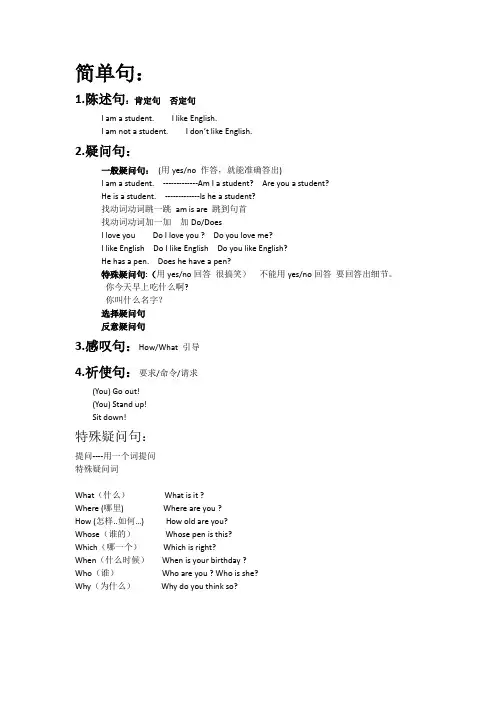
简单句:1.陈述句:肯定句否定句I am a student. I like English.I am not a student. I don’t like English.2.疑问句:一般疑问句:(用yes/no 作答,就能准确答出)I am a student. -------------Am I a student? Are you a student?He is a student. -------------Is he a student?找动词动词跳一跳am is are 跳到句首找动词动词加一加加Do/DoesI love you Do I love you ? Do you love me?I like English Do I like English Do you like English?He has a pen. Does he have a pen?特殊疑问句:(用yes/no回答很搞笑)不能用yes/no回答要回答出细节。
你今天早上吃什么啊?你叫什么名字?选择疑问句反意疑问句3.感叹句:How/What 引导4.祈使句:要求/命令/请求(You) Go out!(You) Stand up!Sit down!特殊疑问句:提问----用一个词提问特殊疑问词What(什么)What is it ?Where (哪里) Where are you ?How (怎样..如何…) How old are you?Whose(谁的)Whose pen is this?Which(哪一个)Which is right?When(什么时候)When is your birthday ?Who(谁)Who are you ? Who is she?Why(为什么)Why do you think so?特殊疑问句1.陈述语序她在唱歌She is singing there.Who is singing there?[对主语提问直接用陈述句语序]2.疑问词+“一般疑问句”回顾一般疑问句:(1)含be 动词I am a student –Am I a student?(大脑进了某种液体) Are you a student?He is student-----Is he a student?[找动词动词跳一跳am is are 跳到句首](2)不含be动词I love you------Do you love me ?He loves you-------Does he love you?[找动词动词加一加加Do/Does ]I love English. Who loves English?What do you love?特殊疑问句两种构成A.当疑问词或者疑问词修饰的词作主语/对主语提问, 用疑问词+陈述语序Who loves English B…..不做主语,疑问词+一般疑问句What do you love?Where is my schoolbag?初一常见疑问词1.Who 10.what time 19.How soon2.Whom 11.What color 20.How heavy3.Whose 12.what size4.What 13.How many5.Which 14.How much6.Where 15.how long7.When 16. How far8.Why 17. How often9.How 18.How big特殊疑问句练习:就划线部分提问My school bag is on the desk.(1) (2)(3)(1)Whose school bag is on the desk?(2)Where is my school bag?(3)What is on the desk?He has three balls.(1) (2)_______(3)(1)Who has three balls?(2)How many balls does he have?(3)What does he have?She likes bananas.(1)(2)(1)Who likes bananas?(2)What does she like?The soccer ball is 6 dollars.(1)(2)(1)What is 6 dollars?(2)How much is the soccer ball?My birthday is on June 3rd.(1)(2)(1)Whose birthday is on June 3rd(2)When is your birthday?Bob’s favorite subject is art.(1)(2)(1)Whose favorite subject is art?(2)What’s your favorite subject?。
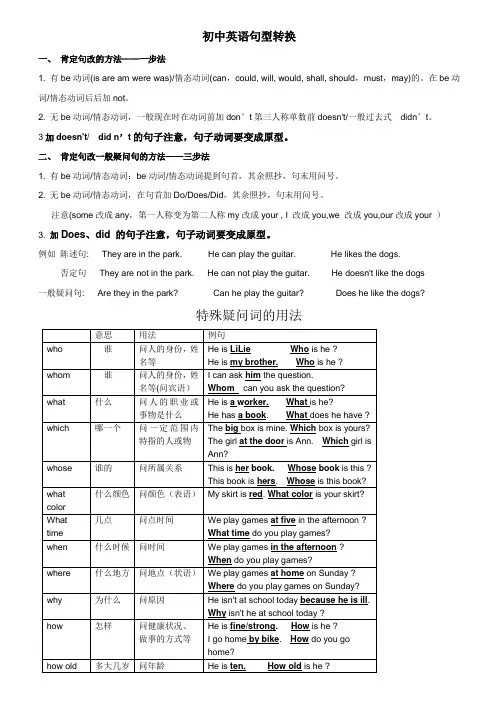
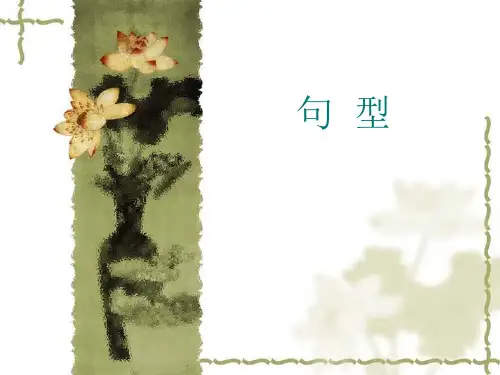
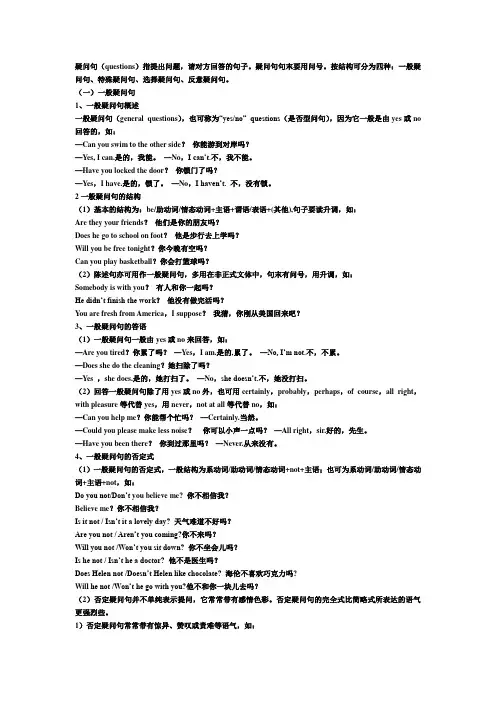
疑问句(questions)指提出问题,请对方回答的句子。
疑问句句末要用问号。
按结构可分为四种:一般疑问句、特殊疑问句、选择疑问句、反意疑问句。
(一)一般疑问句1、一般疑问句概述一般疑问句(general questions),也可称为“yes/no” questions(是否型问句),因为它一般是由yes或no 回答的,如:—Can you swim to the other side?你能游到对岸吗?—Yes, I can.是的,我能。
—No,I can’t.不,我不能。
—Have you locked the door?你锁门了吗?—Yes,I have.是的,锁了。
—No,I haven’t. 不,没有锁。
2一般疑问句的结构(1)基本的结构为:be/助动词/情态动词+主语+谓语/表语+(其他),句子要读升调,如:Are they your friends?他们是你的朋友吗?Does he go to school on foot?他是步行去上学吗?Will you be free tonight?你今晚有空吗?Can you play basketball?你会打篮球吗?(2)陈述句亦可用作一般疑问句,多用在非正式文体中,句末有问号,用升调,如:Somebody is with you?有人和你一起吗?He didn’t finish the work?他没有做完活吗?You are fresh from America,I suppose?我猜,你刚从美国回来吧?3、一般疑问句的答语(1)一般疑问句一般由yes或no来回答,如:—Are you tired?你累了吗?—Yes,I am.是的,累了。
—No, I’m not.不,不累。
—Does she do the cleaning?她扫除了吗?—Yes ,she does.是的,她打扫了。
—No,she doesn’t.不,她没打扫。
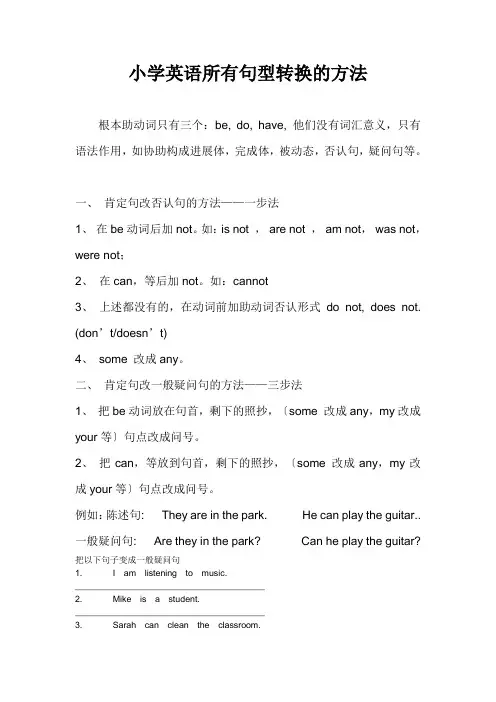
小学英语所有句型转换的方法根本助动词只有三个:be, do, have, 他们没有词汇意义,只有语法作用,如协助构成进展体,完成体,被动态,否认句,疑问句等。
一、肯定句改否认句的方法——一步法1、在be动词后加not。
如:is not ,are not ,am not,was not,were not;2、在can,等后加not。
如:cannot3、上述都没有的,在动词前加助动词否认形式do not, does not. (don’t/doesn’t)4、some 改成any。
二、肯定句改一般疑问句的方法——三步法1、把be动词放在句首,剩下的照抄,〔some 改成any,my改成your等〕句点改成问号。
2、把can,等放到句首,剩下的照抄,〔some 改成any,my改成your等〕句点改成问号。
例如:陈述句: They are in the park. He can play the guitar.. 一般疑问句: Are they in the park? Can he play the guitar?把以下句子变成一般疑问句1. I am listening to music._______________________________________2. Mike is a student._______________________________________3. Sarah can clean the classroom.________________________________________4. They are in the zoo.________________________________________5. There are some flowers in the vase.________________________________________6.This is my sister._________________________________________7.We are sweeping the floor.__________________________________________3、上述都没有的,在句首请助动词Do/Does帮助,剩下的照抄,〔some 改成any,my改成your等〕句点改成问号。

各种时态的一般疑问句、特殊疑问句与陈述句一般疑问句:1. 现在时态:Are you a student?(你是学生吗?)2. 过去时态:Did you go to school yesterday?(你昨天去上学了吗?)3. 将来时态:Will you come to the party tonight?(你今晚会来参加聚会吗?)4. 现在完成时态:Have you finished your homework yet?(你已经完成作业了吗?)5. 过去完成时态:Had you eaten breakfast before you left home?(你离家前吃过早餐了吗?)6. 将来完成时态:Will you have finished your work by tomorrow?(你明天之前会完成工作吗?)7. 现在进行时态:Are you watching TV now?(你现在正在看电视吗?)8. 过去进行时态:Were you studying when I called you?(我给你打电话的时候,你在学习吗?)9. 将来进行时态:Will you be working late tonight?(今晚你会加班吗?)10. 现在完成进行时态:Have you been waiting for me long?(你已经等我很久了吗?)11. 过去完成进行时态:You had been playing basketball for two hours before you got tired.(你打篮球打了两个小时才累了。
)12. 将来完成进行时态:By this time next week, you will have been living in this city for five years.(到下个星期这个时候,你就会在这个城市生活五年了。
)特殊疑问句:1. 现在时态:What is your name?(你叫什么名字?)2. 过去时态:Where did you go on vacation last year?(去年你去哪里度假了?)3. 将来时态:How will you get to the airport tomorrow?(明天你怎么去机场?)4. 现在完成时态:What have you done so far today?(今天到现在为止,你都做了什么?)5. 过去完成时态:When had you finished your work before he arrived?(他到达之前,你已经完成了工作吗?)6. 将来完成时态:How much money will you have saved by the end of the year?(到年底为止,你会存多少钱?)7. 现在进行时态:What are you doing right now?(你现在在做什么?)8. 过去进行时态:What were you reading when I came in?(我进来的时候,你在读什么?)9. 将来进行时态:What will you be doing at this time tomorrow?(明天这个时候,你会在做什么?)10. 现在完成进行时态:What have you been up to lately?(最近你在忙些什么?)11. 过去完成进行时态:What had you been doing all morning before I called you?(我给你打电话之前,你整个早上都在忙什么?)12. 将来完成进行时态:What will you have been studying for three years by the time you graduate?(到你毕业的时候,你会已经学了三年的什么课程?)。

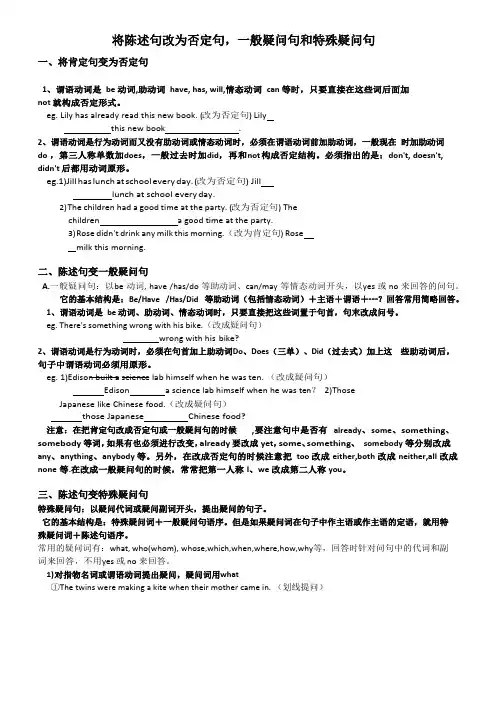
将陈述句改为否定句,一般疑问句和特殊疑问句一、将肯定句变为否定句1、谓语动词是be 动词,助动词have, has, will,情态动词can 等时,只要直接在这些词后面加not 就构成否定形式。
eg. Lily has already read this new book. (改为否定句) Lilythis new book.2、谓语动词是行为动词而又没有助动词或情态动词时,必须在谓语动词前加助动词,一般现在时加助动词do ,第三人称单数加does,一般过去时加did,再和not 构成否定结构。
必须指出的是:don't, doesn't, didn't 后都用动词原形。
eg.1)Jill has lunch at school every day. (改为否定句) Jilllunch at school every day.2)T he children had a good time at the party. (改为否定句) Thechildren a good time at the party.3)R ose didn't drink any milk this morning.(改为肯定句) Rosemilk this morning.二、陈述句变一般疑问句A.一般疑问句:以be 动词, have /has/do 等助动词、can/may 等情态动词开头,以yes 或no 来回答的问句。
它的基本结构是:Be/Have /Has/Did 等助动词(包括情态动词)+主语+谓语+┄?回答常用简略回答。
1、谓语动词是be 动词、助动词、情态动词时,只要直接把这些词置于句首,句末改成问号。
eg. There's something wrong with his bike.(改成疑问句)wrong with his bike?2、谓语动词是行为动词时,必须在句首加上助动词Do、Does(三单)、Did(过去式)加上这些助动词后,句子中谓语动词必须用原形。


一、陈述句:用于陈述事实和观点。
包括肯定结构和否定结构,句末用句号。
二、肯定句→否定句:1.主语+系动词be + 表语。
在be(am\is\are\was\were)后加not;如:The dog is playing in the room. → The dog is not playing in the room.2. 主语+ 情态动词+ 动词原形+ 其他。
在情态动词(can ,should,must ,would)后面加not;如:He can dance.→H e can not dance.3.主语+实义动词+其他。
要借助助动词do , does, did;①句中动词为原形的,加don’t .如: I like apples. →I don’t like apples.②句中动词为三单式的,加doesn’t,并将三单式的动词还原成原形。
如:He likes apples.→ He doesn’t like apples.③时态为过去时的,要加didn’t而且动词过去式要改为原形,如:I went to school yesterday .→I didn’t go to school yesterday .注:肯定句中的some、something、somebody等在否定句中分别改成any、anything、anybody等,already要改成yet,too改成either, both改成neither, all改成none等。
如:There are some students in the classroom.→There are not any students in the classroom.三、肯定句→一般疑问句——三步法●一般疑问句:只能用yes(是)或no(否)来回答的疑问句。
一般结构:系动词be/情态动词/助动词+主语+其他成分通常回答:肯定:Yes,主语+提问的系动词be/助动词/情态动词.否定:No,主语+提问的系动词be/助动词/情态动词的否定形式.如:① Is she from America? 她来自美国吗?-Yes, she is. / No, she isn't. 是的,她是。

暑假专题——陈述句、疑问句[学习过程]一. 陈述句:是用来说明一个事实或陈述说话人的看法的句子。
如:我每天骑自行车上学。
I go to school by bike every day.我相信我一定会赢得这场篮球比赛。
I’m sure to win the basketball game.二. 疑问句疑问句有四种形式,一般疑问句、特殊疑问句、反意疑问句和选择疑问句。
1. 一般疑问句:凡是以情态动词(can, could, must, may等)助动词(do, does, did, have等)以及系动词be(am, is, are, was, were)开头的疑问句都叫一般疑问句,一般疑问句需以yes或no回答。
如:你喜欢住在中国吗?Do you enjoy living in China?昨天你观看了中国队和日本队之间的排球比赛吗?Did you watch the volleyball math between the Chinese and Japanese teams?一般疑问句的答语通常用yes作肯定回答,用no作否定回答。
一般情况下问句用什么提问,答语也用这样的词来回答。
如:Are you good at swimming?你擅长于游泳吗?Yes, I am. / No, I’m not.是的,我是。
/不,我不擅于。
Did you go shopping yesterday?昨天你购物了吗?Yes, I did. / No, I didn’t.是的,我购物了。
/不,我没有。
有时候,一般疑问句的答语不用yes或no来回答,而用其他一些词语。
有时,答语不用开头的词语,而用其他词语。
如:(1)May I use your pen?我可以用你的钢笔吗?Certainly. Here you are.当然可以,给你。
(2)May we go home now?我们现在可以回家吗?No, you may not. / can’t / mustn’t.不,你不可以。
小升初历史陈述句、一般疑问句、特殊疑问句及练习历史陈述句(Descriptive Sentences)历史陈述句是用来陈述关于历史事件、人物或事实的句子。
下面是一些常用的历史陈述句的例子:1. 中国的长城被认为是世界上最伟大的建筑之一。
2. 二战是20世纪最重要的历史事件之一。
3. 孔子是中国古代最著名的哲学家之一。
4. 亚历山帝统一了希腊和波斯。
5. 印度河流域是古代印度文明的发源地之一。
一般疑问句(Yes/No Questions)一般疑问句是用来询问关于历史事件、人物或事实的句子,可以用是或者否来回答。
下面是一些常用的一般疑问句的例子:1. 汉朝是中国历史上第一个中央集权的王朝,对吗?2. 罗马帝国是古代罗马的一个政权,对吗?3. 地中海是古代世界最重要的内海之一,对吗?4. 古埃及是世界上最古老的文明之一,对吗?5. 孟子是中国古代著名的思想家之一,对吗?特殊疑问句(Wh- Questions)特殊疑问句是用来询问关于历史事件、人物或事实的句子,并且需要更详细的回答。
下面是一些常用的特殊疑问句的例子:1. 古代埃及人崇拜哪些神灵?2. 的创始人是谁?3. 印度河文明的兴起与何时期相对应?4. 古希腊的民主制度起源于哪个城邦?5. 中国古代文化的象征物有哪些?练请将下面的句子改写成一般疑问句和特殊疑问句:1. 孔子是中国古代的哲学家之一。
一般疑问句:孔子是中国古代的哲学家之一吗?特殊疑问句:孔子是属于哪些中国古代哲学家之一?2. 古希腊发展了许多对现代世界有重大影响的艺术和科学。
一般疑问句:古希腊发展了许多对现代世界有重大影响的艺术和科学吗?特殊疑问句:古希腊发展了哪些对现代世界产生了重大影响的艺术和科学?3. 第一次世界大战爆发于1914年。
一般疑问句:第一次世界大战是于1914年爆发的吗?特殊疑问句:第一次世界大战是在哪一年爆发的?4. 远古时期的人们使用简单的工具来生存。
一般疑问句:远古时期的人们使用简单的工具来生存吗?特殊疑问句:远古时期的人们使用什么样的工具来生存?5. 埃及的金字塔是世界上最知名的古老建筑之一。
小升初数学陈述句、一般疑问句、特殊疑
问句及练习
一、数学陈述句
数学陈述句是用来陈述事实、描述问题或给出结论的句子。
它们没有疑问的语气,表示的是肯定的说法。
下面是一些常见的数学陈述句的例子:
1. 圆的周长公式是2πr。
2. 三角形的内角和等于180度。
3. 直角三角形的斜边长度可以通过勾股定理计算。
二、一般疑问句
一般疑问句用来询问事实或情况,并希望得到肯定或否定的回答。
一般疑问句的基本结构是将助动词放在主语前面。
下面是一些常见的数学一般疑问句的例子:
1. 你会计算梯形的面积吗?
2. 他们已经研究了三角形的性质吗?
3. 你能解方程吗?
三、特殊疑问句
特殊疑问句用来询问特定的信息。
特殊疑问句通常以疑问词开头,疑问词包括何、谁、哪、什么、怎样等。
下面是一些常见的数学特殊疑问句的例子:
1. 什么是平行线?
2. 如何计算一个梯形的面积?
3. 周长和面积有什么区别?
四、练
1. 写出一个数学陈述句的例子。
2. 将下面的句子改写成一般疑问句:"这个三角形的周长是10厘米。
"
3. 用特殊疑问句回答问题:"如何计算一个长方形的面积?"
以上是关于小升初数学陈述句、一般疑问句、特殊疑问句及练习的内容。
希望对你有所帮助!。
小升初科学陈述句、一般疑问句、特殊疑问句及练习科学陈述句是表达一个事实或观点的句子,一般疑问句是用来询问一个事实或观点的句子,特殊疑问句则是用来询问一个特定的信息的句子。
在小升初科学考试中,我们需要掌握这些句子的用法和结构。
科学陈述句科学陈述句用于陈述一个确定的事实或观点,句子结构通常是主语 + 谓语动词 + 宾语。
- 例句1:太阳是星球。
(The sun is a star.)- 例句2:水的凝固点是零摄氏度。
(The freezing point of water is zero degrees Celsius.)一般疑问句一般疑问句用于询问一个事实或观点是否正确,句子结构通常是助动词 + 主语 + 谓语动词 + 宾语?- 例句1:你是学生吗? (Are you a student?)- 例句2:这本书是你的吗? (Is this book yours?)特殊疑问句特殊疑问句用于询问一个特定的信息,句子结构通常是疑问词+ 助动词 + 主语 + 谓语动词 + 其他成分?- 例句1:你是从哪个国家来的? (Where are you from?)- 例句2:你在哪里出生的? (Where were you born?)练请根据下面的句子,将其改写成一般疑问句和特殊疑问句,并给出相应的答案。
1. 小猫是哺乳动物。
(Cats are mammals.)- 一般疑问句:Are cats mammals?- 特殊疑问句:What are cats?2. 彩虹由什么组成? (What is a rainbow made of?)- 一般疑问句:Is a rainbow made of something?- 特殊疑问句:What is a rainbow made of?3. 地球绕着太阳转。
(The Earth orbits around the sun.)- 一般疑问句:Does the Earth orbit around the sun?- 特殊疑问句:What does the Earth orbit around?4. 硫酸是一种酸。
小升初英文写作陈述句、一般疑问句、特殊疑问句及练习陈述句 (Statement Sentences)陈述句用于陈述一个事实或描述一个情况,它们以句号结尾。
例句:- I like to play basketball. (我喜欢打篮球。
)- She is a good student. (她是个好学生。
)- The cat is sleeping. (猫在睡觉。
)一般疑问句 (Yes/No Questions)一般疑问句用于询问一个事实,需要使用助动词(do/does/did)或be动词(is/am/are/was/were)来构成。
例句:- Do you like to play basketball? (你喜欢打篮球吗?)- Is she a good student? (她是个好学生吗?)- Was the cat sleeping? (猫在睡觉吗?)特殊疑问句 (Wh-Questions)特殊疑问句用于询问某个特定信息,通常以疑问词(who/what/when/where/why/how)开头。
例句:- Who is your favorite teacher? (你最喜欢的老师是谁?)- What is your favorite sport? (你最喜欢的运动是什么?)- When did you go to the park? (你什么时候去公园的?)- Where is the nearest library? (最近的图书馆在哪里?)- Why are you late? (你为什么迟到了?)- How do you spell your name? (你的名字怎么拼写?)练请根据以下情况,用陈述句、一般疑问句或特殊疑问句进行适当回答。
1. 你的名字是什么?2. 他喜欢吃苹果吗?3. 昨天是星期几?4. 妈妈在哪里工作?5. 你为什么没来上学?6. 学校门口有一个公园吗?参考答案:1. 我的名字是...2. Does he like to eat apples?3. Yesterday was...4. Where does mom work?6. Is there a park near the school gate?。